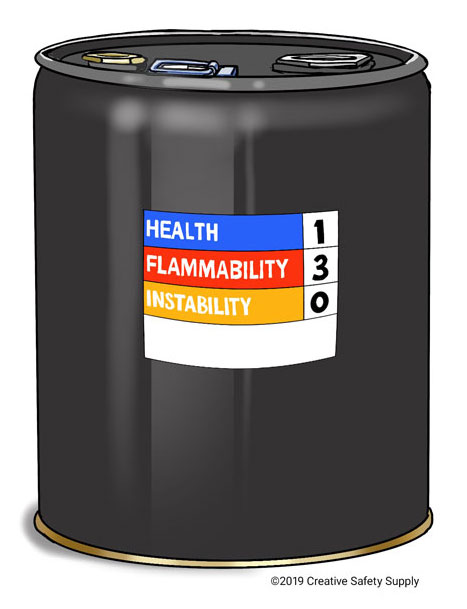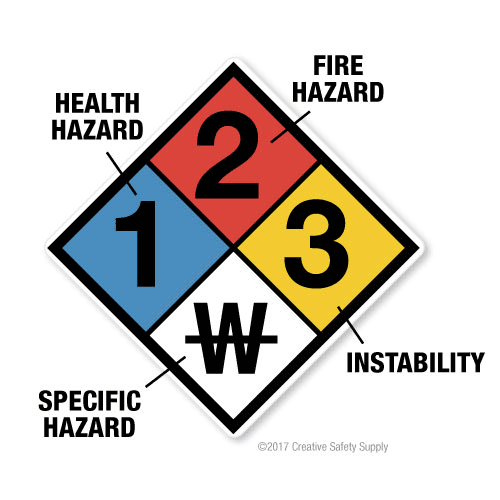
Companies that want to remain in compliance with the OSHA Hazardous Communication Standard often turn to the Hazardous Materials Identification System (HMIS), which was developed by the American Coatings Association. Using this system allows employees to identify potential hazards in different areas at just a glance. It can also provide useful information about those hazards by listing numbers to indicate the severity of the risk.
HMIS-compliant labels can be purchased pre-printed, or they can be created on site with an industrial label printer. Both options are effective, and the best choice will largely depend on the situation in a facility. Facilities that use multiple different types of hazardous materials will often benefit from the flexibility of being able to print compliant labels on site. There are also options that have the hazardous color bars pre-printed, and then just require the numbers to be added with a label printer, which can be an effective option for HMIS too.

Understanding the Hazardous Materials Identification System
There are a number of different ways that this system can be used in facilities to convey the necessary information. Some companies use a color bar, and others will use a diamond format, both of which can be printed onto HMIS labels and applied anywhere that they are needed.
HMIS Color Bar
The colors used in the label allow those in the area to identify what types of hazards are present with just a glance. This can help them to be able to respond properly when there is a spill or other event, or to take proper precautions when entering the area. The colors used on labels are as follows:
- Blue - Blue indicates a hazard related to the health of people in the area.
- Red - The red color is used to indicate what level of flammability hazards are present.
- Orange - Physical hazards are identified by the orange color. Note that prior to 2002, physical hazards were identified with yellow, so older color bars may still reflect this.
- White - The information that is in white is used to note what types of personal protection equipment may be needed.
Within each of the different sections there is a spot for a number, which will indicate the severity of the hazard. The hazard levels range from zero to four, with zero representing no threat at all and four representing an extreme hazard.
Each hazard area has specific information associated with the numbers. For example, the numbers in the red (flammability) section has the following meanings:
- 0 - The materials will not burn.
- 1 - Materials can burn, but must be preheated before any type of ignition will occur. These materials need to have a flash point above 200F.
- 2 - Materials will ignite at moderately heated temperatures. The flash point can be between 100F and 200F.
- 3 - Materials can ignite under normal temperatures and have flash points x.y,..b 73U abe 100Uv
- 4 - Extremely flammable liquids or gasses with a flash point below 73F.
Each type of hazard has detailed information associated with the different levels. Anyone working with or around hazardous materials should be trained not only on what the colors mean, but what each of the five levels for each hazard type will mean.
Hazardous Materials Diamond
 The hazardous materials diamond is one of the most commonly seen types of hazard warning systems today. These diamonds are seen in many different facilities, and they are commonly on the backs of trucks that transport hazardous chemicals.
The hazardous materials diamond is one of the most commonly seen types of hazard warning systems today. These diamonds are seen in many different facilities, and they are commonly on the backs of trucks that transport hazardous chemicals.
The diamond, which can be seen here, is divided up into four sections. The section to the left is blue for health related hazards, the top section is red for flammability, the right section is orange (or yellow) for physical or reactive hazards, and the bottom section is white, which indicates what type of protective equipment is needed when around the hazardous materials.
The hazardous materials diamond is very recognizable, and most emergency responders are trained to recognize what each section means. This can help them to react safely in situations where there is an accident or other risk to themselves and those in the area.
HMIS Resources
In order to benefit from the HMIS system, companies need to be able to convey the information to employees and others in the area quickly and easily. There are many resources available to help with this process. Choosing the right ones for a given situation will help ensure that a company not only provides the right information to those in an area, but can also do it in the most affordable way ever.
HMIS Signs
Corresponding NFPA signs can be hung on walls, vehicles, or other areas of a facility in order to let people know of potential hazards; one of the most common examples of this sign is seen on the back of trucks that transport hazardous materials. These signs are made of metal or plastic, and use the NFPA diamond format. In many cases, each segment of the diamond can be removed to change the number based on what chemical is being moved.
Hazardous Labels
Labels are a great option for areas where the hazard is going to be consistent. If a company is filling a barrel with a particular, printing off a label is a good way to let those who are around see what the hazard is. This is helpful not only for a specific facility, but also when sending the chemicals to other facilities so there is on confusion over what is in the barrels and what the hazards may be.
HMIS Training
The Hazardous Materials Identification System is supposed to make it easier for people to identify what dangers are associated with specific materials. Anyone who works in an area with any type of hazardous materials will need to get the proper training so that they can look at HMIS labels or signs and immediately understand what potential risks exist. This training should be done when employees or others are brought into the facility, and then refresher courses should be given periodically over time to ensure everyone is as safe as possible.
Resources
Similar Articles
- Understanding the NFPA 704 Diamond Labeling System
- NFPA 704
- Valve Tags: Guide for Pipe Identification
- Arc Flash Labeling (Updated)
- Hazardous Waste Disposal
- Handling Hazardous Materials Safely
- What is HAZCOM? (Hazard Communication Definition + OSHA Standards)
- Safety Colors (OSHA Guidelines and Color Codes)
- ANSI Color Codes for Pipe Marking
- GHS: The Globally Harmonized System for Labeling [Updated 2019]


